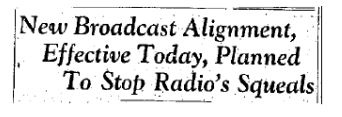The Great Frequency Move of 1928
It was on November 11, 1928 that the Federal Radio Commission (FRC) moved many stations from all across the country to new locations on the dial.
Part of it was to reduce interference. Over the previous few years, many stations had discovered the Department of Commerce (DOC) had little power, and was pretty much forced to give licenses to anyone who asked.
Then stations “jumped” to frequencies they were not assigned and added higher power, trying to improve their signal. In some places local stations fought like cats and dogs. A demonstration in Los Angeles was dubbed “The Interference Hour,” with eleven stations paired off purposely to show how bad it could get.
The DOC had lost control of the situation.
The Radio Act of 1927
Part of the legal mess they found themselves in was the lack of “equality” among the radio districts. Supposedly, each of the five regions was to have an equal distribution of high power, regional, and local stations. The actual result after the first decade of broadcasting was a lot of high-power stations gathered in the biggest cities – and not much out in the “Mid-America” region – leaving a lot of what was called “white space,” where reliable reception was not always available to many people.
A little help came with the Radio Act of 1927. It finally gave the FRC enough power to control things. The FRC then took a strong look at each of the 732 stations on the air and slowly started to reduce the licenses for those not really operating as the FRC desired. Trying to avoid legal hassles where possible, every so often a small bunch of stations were shifted. Also a number of share-time situations were set up.
Clearing the Decks
As the FRC realigned the dial, some stations were deemed not to be essential – and were not granted renewal authorization.
Among the stations that disappeared were the so-called “portable stations” that had authorization to broadcast from almost anywhere in the region – usually at state fairs, expositions, etc.
Eventually 164 stations were targeted for deletion as not meeting a new standard of stations operating “in the Public Interest, Convenience, or Necessity.” Of course, lawsuits followed. However, the FRC won most cases.
From 732, the FRC ended up with 585 stations, a reduction of 147 stations.
November 11, 1928
This was the date chosen for the stations left to play musical chairs.

Newspapers around the country like the Davenport, IA, Democrat and Leader played it up big.
Here is another headline from the Galveston, Texas Daily News.

The new assignments did, in fact, eliminate many situations where too many stations were jammed too close to each other. By separating stations – and moving them up or down the dial as necessary – the FRC made a lot of listeners happy.
(The list of stations and text of the government announcement are below.)
On the other hand, not all stations were happy about the move and, inevitably, lawsuits were initiated by those stations that sought better outcomes. For example, in Boston, department store magnate John Shepard was unhappy he did not get a nice slot on the low end of the dial. A lot of political firepower was also brought into the fights.
Nevertheless, the Radio Act of 1927 did provide enough of a legal basis for the FRC’s actions, so most of the lawsuits were, again, unsuccessful. However, in order to put a final stop to the litigation, Congress eventually passed the Radio Act of 1934, creating the FCC, with specific powers to give the government agency an even firmer grip on the nation’s airwaves.
All-in-all, the reallocation was considered very successful at the time. Some referred to it as bringing “Order out of Chaos.”
—
With thanks to Donna Halper for researching and sharing the headline graphics.
